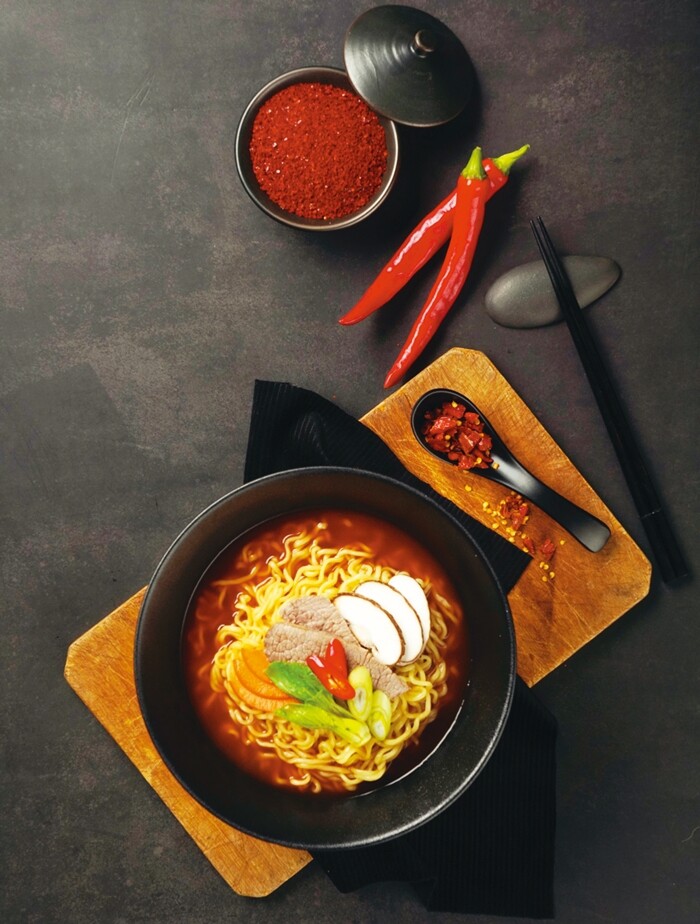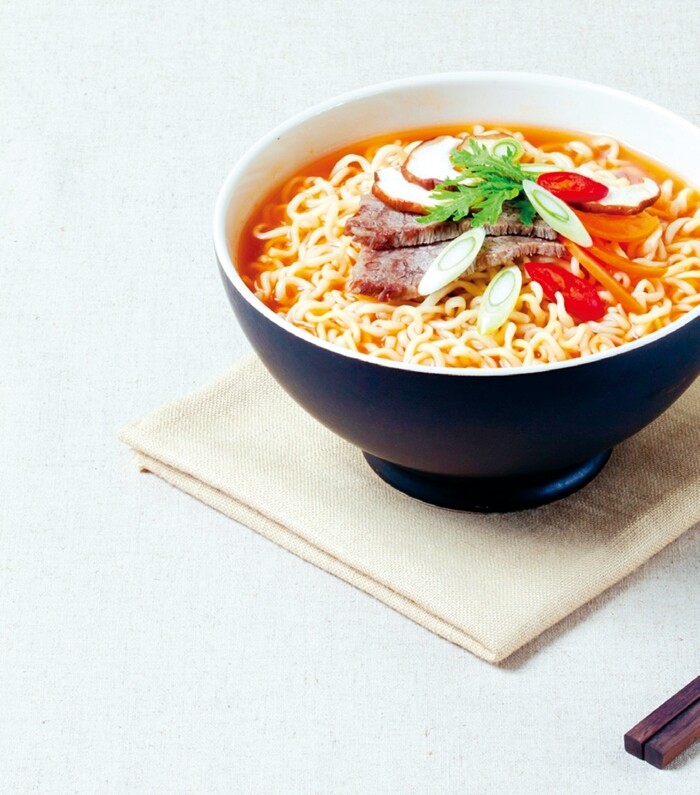hankyoreh
Links to other country sites 다른 나라 사이트 링크
World famous Korean instant noodle: truth and misconceptions

After a concert overseas, Jimin, a member of K-pop group BTS, went back to his hotel room for a meal of steak and Hot Chicken Flavor Ramen. As Jimin chowed down on the ramen noodles, he had to wipe off the sweat beading on his nose, testifying to the noodles’ spiciness. But all that spice didn’t change their mouthwatering goodness.
The BTS boys make a point of eating Hot Chicken Flavor Ramen after every concert, bringing the product to the attention of fans around the world. The “soul food” that helps Jimin relax after another exhausting day has triggered a global craze for Korean ramen noodles (also spelled “ramyeon” and “ramyun”).
Beloved Korean television host Yoo Jae-suk has been recently tickling viewers’ funny bone with his multiple personas in the show “Hangout with Yoo,” including his role as the “lonely interviewer” at Joy and Music Technology.
After a long day of interviews, Yoo plopped down on the couch and tucked into a bowl of Shin Ramyun topped with green onion kimchi — rather than the spicy stir-fried pork or kimchi stew one might expect. Since the show was broadcast on a weekend evening, quite a few viewers probably had their own pot of ramen noodles bubbling on the stove.
For some time now, ramen has been a Korean comfort food that instantly wipes away the day’s stress. That’s true for boomers who grew up watching their grandmother wash down spicy ramen noodles with a cup of rice wine, for millennials who swap recipes about how to match ramen with seasonal produce, and even for foreigners inspired to make Chapaguri (a combination of the Chapagetti and Neoguri ramen noodle brands) after watching the film “Parasite.”
Korea’s ramen exports in 2020 were worth US$636.2 million, up 29.3% from the previous year. That was the first time that ramen exports have exceeded US$600 million. 2020 was also the first year that Nongshim — the manufacturer of Shin Ramyun, Chapagetti, and Neoguri — saw its sales exceed 2 trillion won (US$1.8 billion).
Samyang Food, another major ramen manufacturer, also posted a sales record of 648.5 billion won (US$582.7 million) last year, with overseas sales climbing above US$270 million for the first time. Sales in Southeast Asia and the US were boosted by the huge popularity of the Hot Chicken Flavor brand.

Paldo’s ramen products saw sales of 297.1 billion won (US$266.78 million) last year, a year-on-year increase of 9.2%. In particular, the Dosirac brand of cup ramen accounted for 60% of the Russian market.
Ramen used to be just a snack, but it’s now become a cuisine, appearing in the foreign media alongside K-pop stars. One overseas music publication tweeted a photograph of Jimin alongside the Hot Chicken Flavor Ramen that he was eating.
New York Times reporters and food experts selected Shin Black Noodle Soup as number one in a list of the world’s best instant noodles. The same product was chosen as the world’s best instant noodle by The Travel, a website specializing in travel.
According to data recently published by the World Instant Noodles Association, South Koreans consumed 4.13 billion servings of instant noodles in 2020, ranking eighth in the world. While that might sound lower than expected, that works out to 79.7 servings of instant noodles per capita, the highest in the world.
In short, ramen has become Koreans’ comfort food, which they eat, on average, once every four or five days.
But how well do we know our ramen? In the rest of the article, we’ll clear up some misconceptions as we delve into the truth of these ramen noodles.

Ramen seasoning packets are made of a mixture of ingredients, including beef, bones, garlic, onions, and soy sauce, which are boiled down into a concentrate that’s then dried and powdered.
It’s a mistake to think it’s just a jumble of chemical additives. Most of the ingredients are extracted from natural foods. The pack of ramen garnish is also made of foods that have been dried to preserve their original flavor and fragrance.
Wheat flour and water are kneaded into a dough that’s flattened in rollers and then run through a noodle-cutting machine. After being cooked in a steam box at more than 212 degrees Fahrenheit, the noodles are either fried in a replenishing vat of palm oil or dried under hot air, depending on the product, before being cooled.
“Ramen contains lots of preservatives.”Because ramen is a well-known example of an instant food product, there is a strong preconception that it is packed with preservatives. But ramen contains no preservatives at all. There’s a simple reason for that: the microbes that are one of the biggest causes of food spoilage require at least 12 percent moisture content to survive. Ramen noodles and soup contain only around 4 to 6 percent moisture, which means they can be stored for a long time at room temperature without allowing microbes to multiply. It’s the same principle that permits rice and wheat flour to be stored at room temperature without added preservatives.
“Ramen is not a diet food.”Ramen typically contains about 500 calories, which is a fair amount for a single adult meal. The recommended daily calorie intake for an adult is typically in the range of 2,000 to 2,500 calories, which means a single packet of ramen accounts for one-fourth to one-fifth of the recommended total.
“Eating ramen before bed will make your face swell up.”It isn’t eating ramen that makes your face swell. Eating any food before going to bed is what causes the swelling. The human body releases moisture through physical activity, but when we sleep, our body isn’t moving, and the release of moisture is reduced to prevent too much urine from accumulating in the bladder. So when we go to bed right after eating something, the reason our face swells is because moisture isn’t being released. It’s not eating any particular food that causes swelling.
“Ramen is nutritionally imbalanced.”This may be the single most unjust preconception about ramen. According to the South Korean Ministry of Health and Welfare’s nutrition standards for 2020, the best diet includes roughly 55-65% carbohydrates, 7-20% proteins, and 15-30% fats from among the essential nutrients. In the case of ramen, the respective ratio is 62 to 8 to 30, which means it is suited to the MOHW guidelines. Nissin Foods, Japan’s biggest instant ramen maker, published a study that showed Nongshim’s Shin Ramyun to have a similar nutrient ratio to bibimbap when eaten with kimchi.
“Ramen is difficult to digest.”Digestion depends on our constitution. As the flour that makes up ramen’s main ingredient mixes with water, gluten is formed. Westerners have long consumed bread as a staple, so they are able to digest flour-based foods effectively, but some Easterners lack the digestive capabilities to break down gluten. This means that people who have trouble digesting ramen also have difficulty digesting other foods that contain gluten, including bread, sujebi (pulled dough soup) and kalguksu (knife-cut noodle soup).
A bonus for users of the different sites for ramen aficionados is the variety of healthy recipes they provide. At the Noodle Foodle website (www.noodlefoodle.com, Korean only), you can find unique ramen recipes posted by ordinary people, along with roughly 1,000 recipes developed by professional chefs and Nongshim researchers, using ingredients such as mushrooms, garlic, vegetables and seafood.
By Kim A-ri, contributing writer
Please direct comments or questions to [english@hani.co.kr]
Editorial・opinion
![[Column] Season 2 of special prosecutor probe may be coming to Korea soon [Column] Season 2 of special prosecutor probe may be coming to Korea soon](https://flexible.img.hani.co.kr/flexible/normal/500/300/imgdb/original/2024/0426/3317141030699447.jpg) [Column] Season 2 of special prosecutor probe may be coming to Korea soon
[Column] Season 2 of special prosecutor probe may be coming to Korea soon![[Column] Park Geun-hye déjà vu in Yoon Suk-yeol [Column] Park Geun-hye déjà vu in Yoon Suk-yeol](https://flexible.img.hani.co.kr/flexible/normal/500/300/imgdb/original/2024/0424/651713945113788.jpg) [Column] Park Geun-hye déjà vu in Yoon Suk-yeol
[Column] Park Geun-hye déjà vu in Yoon Suk-yeol- [Editorial] New weight of N. Korea’s nuclear threats makes dialogue all the more urgent
- [Guest essay] The real reason Korea’s new right wants to dub Rhee a founding father
- [Column] ‘Choson’: Is it time we start referring to N. Korea in its own terms?
- [Editorial] Japan’s rewriting of history with Korea has gone too far
- [Column] The president’s questionable capacity for dialogue
- [Column] Are chaebol firms just pizza pies for families to divvy up as they please?
- [Column] Has Korea, too, crossed the Rubicon on China?
- [Correspondent’s column] In Japan’s alliance with US, echoes of its past alliances with UK
Most viewed articles
- 1‘We must say no’: Seoul defense chief on Korean, USFK involvement in hypothetical Taiwan crisis
- 2N. Korean delegation’s trip to Iran shows how Pyongyang is leveraging ties with Moscow
- 3‘Weddingflation’ breaks the bank for Korean couples-to-be
- 4Korea sees more deaths than births for 52nd consecutive month in February
- 5[Editorial] New weight of N. Korea’s nuclear threats makes dialogue all the more urgent
- 6[Column] Park Geun-hye déjà vu in Yoon Suk-yeol
- 7[Column] Has Korea, too, crossed the Rubicon on China?
- 8[Guest essay] The real reason Korea’s new right wants to dub Rhee a founding father
- 9Will NewJeans end up collateral damage in internal feud at K-pop juggernaut Hybe?
- 10Why Korea shouldn’t welcome Japan’s newly beefed up defense cooperation with US